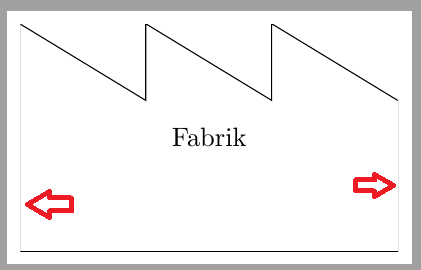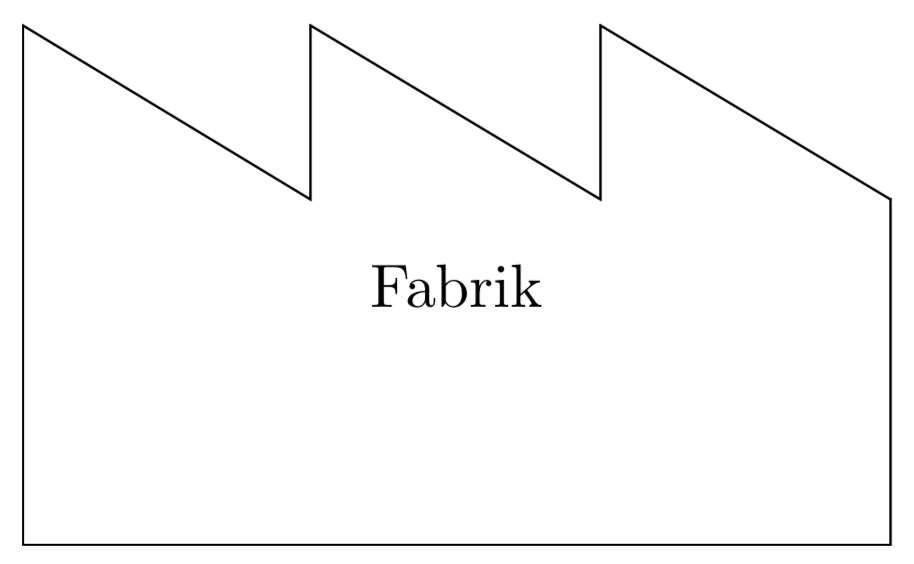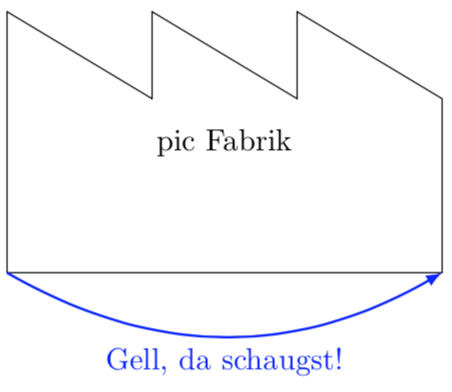|
Wie erreiche ich, dass die dünneren Linien normal gezeichnet werden? Öffne in Overleaf
\documentclass[tikz,border=5pt]{standalone} \usetikzlibrary{shapes, calc} \begin{document} \begin{tikzpicture}[] \pgfmathsetlengthmacro{\M}{1cm} \pgfmathsetlengthmacro{\B}{5*\M} \pgfmathsetlengthmacro{\H}{3*\M} \node[name=s,%shape=rectangle,% draw minimum height=\H, minimum width=\B, path picture={ \draw[] ($(s.south east)!2/3!(s.north east)$) -- (s.south east) -- (s.south west) -- (s.north west) -- ([yshift=2/3*\H, xshift=1/3*\B]s.south west) -- ([yshift=0, xshift=1/3*\B]s.north west) -- ([yshift=2/3*\H, xshift=2/3*\B]s.south west) -- ([yshift=0, xshift=2/3*\B]s.north west) -- ([yshift=2/3*\H, xshift=3/3*\B]s.south west) ; } ] {Fabrik}; \end{tikzpicture} \end{document} |
|
Indem Du dafür sorgst, dass die Linien nicht weggeclippt werden, weil sie aus dem path picture rausschauen. Öffne in Overleaf
\documentclass[tikz,border=5pt]{standalone} \usetikzlibrary{calc} % shapes wird hier nicht gebraucht \begin{document} \begin{tikzpicture}[] \pgfmathsetlengthmacro{\M}{1cm} \pgfmathsetlengthmacro{\B}{5*\M} \pgfmathsetlengthmacro{\H}{3*\M} \node[name=s,%shape=rectangle,% draw minimum height=\H, minimum width=\B, path picture={ \draw[] ([xshift=-\pgflinewidth]$(s.south east)!2/3!(s.north east)$) -- ([xshift=-\pgflinewidth,yshift=\pgflinewidth]s.south east) -- ([xshift=\pgflinewidth,yshift=\pgflinewidth]s.south west) -- ([xshift=\pgflinewidth,yshift=-\pgflinewidth]s.north west) -- ([yshift=2/3*\H, xshift=1/3*\B]s.south west) -- ([yshift=-\pgflinewidth, xshift=1/3*\B]s.north west) -- ([yshift=2/3*\H, xshift=2/3*\B]s.south west) -- ([yshift=-\pgflinewidth, xshift=2/3*\B]s.north west) -- ([yshift=2/3*\H, xshift=3/3*\B]s.south west) ; } ] {Fabrik}; \end{tikzpicture} \end{document} Die Weise, in der Du den Namen der Öffne in Overleaf
\documentclass[tikz,border=5pt]{standalone} \begin{document} \begin{tikzpicture}[pics/.cd, Fabrik/.style args={% mit Breite #1 und Hoehe #2 und Text #3}{ code={ \draw (#1/2,#2/6) -- (#1/2,-#2/2) -- (-#1/2,-#2/2) -- (-#1/2,#2/2) -- (-#1/6,#2/6) -- (-#1/6,#2/2)-- (#1/6,#2/6) -- (#1/6,#2/2) -- cycle; \node at (0,0) {#3};}}] \pgfmathsetlengthmacro{\M}{1cm} \pgfmathsetlengthmacro{\B}{5*\M} \pgfmathsetlengthmacro{\H}{3*\M} \pic[local bounding box=FBox] {Fabrik=mit Breite {\B} und Hoehe {\H} und Text {pic Fabrik}}; \draw[thick,blue,-latex] (FBox.south west) to[bend right] node[midway,below]{Gell, da schaugst!} (FBox.south east); \end{tikzpicture} \end{document} Es ist wichtig, dass das ganze am Schluß eine node ist. Dazu braucht es wohl diese vielen pgflinwidths.
(15 Feb '19, 11:58)
cis
|



